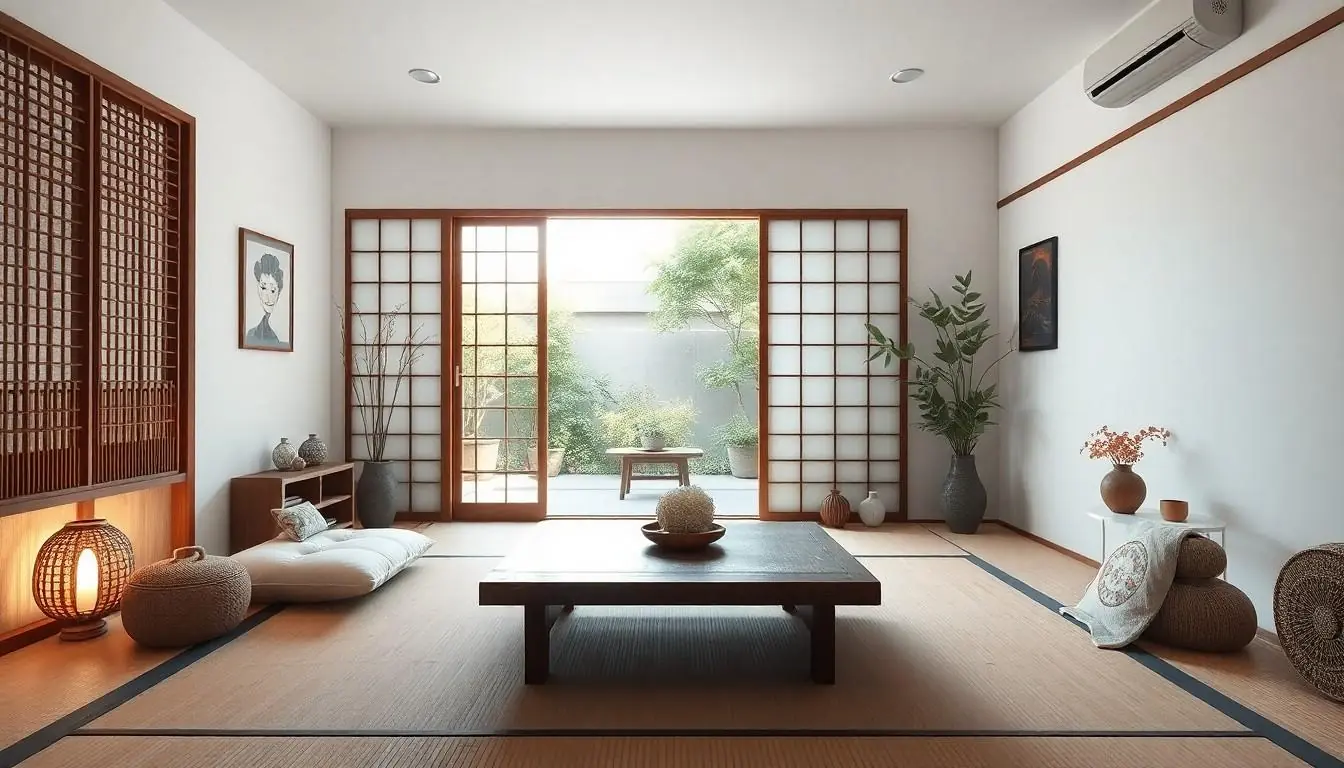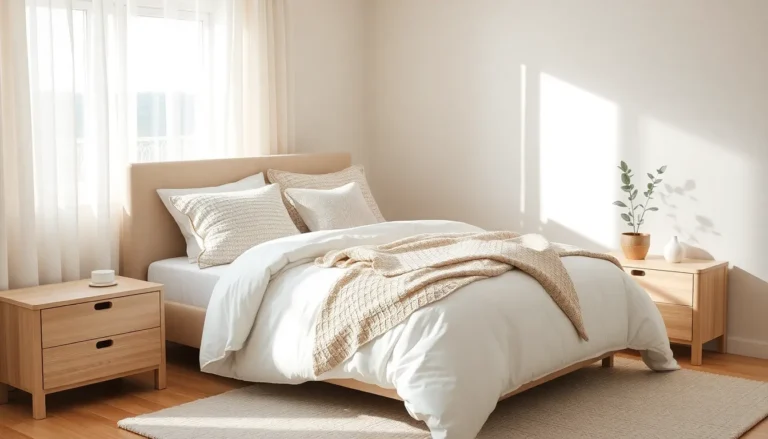Step into the serene world of Japanese-style living rooms, where simplicity meets elegance in a way that could make even Marie Kondo shed a tear of joy. These spaces are not just about aesthetics; they’re a lifestyle choice that embraces minimalism, natural materials, and a touch of Zen. Imagine a room where clutter is as rare as a unicorn sighting and where every piece of furniture seems to have its own calming aura.
If you’ve ever dreamed of transforming your space into a tranquil retreat that whispers “relax” every time you walk in, Japanese design might just be your ticket. Get ready to explore how to create a living room that balances beauty and functionality, making it the perfect backdrop for both quiet reflection and lively gatherings. Who knew achieving inner peace could be so stylish?
Table of Contents
ToggleOverview Of Japanese Style Living Rooms
Japanese-style living rooms embody simplicity and elegance. These spaces often reflect a strong connection to nature through the use of materials like wood, stone, and bamboo. Natural light plays a crucial role, enhancing the tranquil ambiance.
Minimalism stands at the core of Japanese design. This approach encourages the use of less furniture, focusing instead on functionality and open space. Low-profile furniture, such as tatami mats and futons, promotes a sense of groundedness. Soft colors and earthy tones further contribute to an inviting environment.
Incorporating sliding doors, known as shoji, allows flexibility in layout. These doors enhance both aesthetics and spatial dynamics, creating a seamless transition between areas. Plants and natural elements can add warmth to the space, reinforcing the tranquil atmosphere.
Storage solutions prioritize neatness and organization. Built-in shelves or hidden compartments help maintain a clutter-free environment. Decorative items are often minimal, allowing selected pieces to shine without overwhelming the senses.
Cultural significance influences design choices as well. Traditional Japanese art, such as calligraphy or origami, often finds a place within these living rooms, enhancing the overall theme. The integration of these artistic elements fosters a deeper appreciation for craftsmanship and heritage.
Creating a Japanese-style living room involves thoughtful consideration of each element. Achieving harmony among furniture, color, and decor results in a peaceful retreat. Paying attention to detail boosts the space’s aesthetic value while preserving a functional atmosphere.
Key Elements Of Japanese Design

Japanese design integrates various elements that embody tranquility and balance. The focus on structure and aesthetics creates an inviting atmosphere.
Minimalism And Simplicity
Minimalism defines Japanese-style living rooms. It emphasizes clean lines and open spaces, allowing for breathability. Furniture is kept to a minimum, encouraging a clutter-free environment. Only essential items remain, supporting functionality along with simplicity. The absence of excess promotes relaxation. By using low-profile furniture, like tatami mats and futons, the rooms connect occupants to the floor. This grounded appearance enhances the overall calming effect. Soft color palettes further highlight the minimalistic approach, creating a serene backdrop for daily activities.
Natural Materials
Natural materials create a strong connection to the environment. Wood, stone, and bamboo dominate Japanese interiors, introducing organic textures and warmth. These elements evoke a sense of harmony and intimacy with nature. Wooden beams and stone accents add character while maintaining balance. Bamboo, often used in flooring or decor, offers flexibility and durability. Natural fibers in textiles, such as cotton or linen, enhance comfort while supporting the theme of simplicity. Each material choice fosters an overall atmosphere that reflects tranquility and peacefulness. By blending these materials, Japanese design achieves both beauty and functionality.
Color Schemes And Aesthetics
Japanese-style living rooms embrace color schemes that enhance serenity and simplicity. The aesthetic relies heavily on the use of neutral tones and selective accent colors.
Neutral Tones
Neutral tones dominate the palette in Japanese interiors, creating a calm and harmonious environment. Shades like beige, soft grays, and muted whites establish a serene backdrop. Walls often feature light colors to reflect natural light, making spaces feel more expansive. Flooring typically includes natural wood or bamboo, reinforcing warmth and comfort. These choices foster a sense of tranquility that’s essential for relaxation.
Accent Colors
Accent colors enhance the minimalist aesthetic without overwhelming the senses. Subtle hues like soft greens, light browns, or dusty blues introduce nature’s calmness indoors. Decorative elements, such as cushions and artwork, utilize these colors to create visual interest. Selecting one or two accent colors avoids clutter while highlighting specific areas. Additionally, plants provide vibrant pops of color, connecting the indoor space to the outdoors, ensuring the room remains inviting and lively.
Furniture Choices
Selecting furniture for a Japanese-style living room involves a blend of traditional and modern elements that enhance simplicity and functionality.
Traditional vs. Modern Pieces
Traditional furniture often includes tatami mats, low tables, and futons, contributing to a grounded atmosphere. While old styles offer authenticity, modern pieces introduce clean lines and innovative materials. Combining these styles creates visual interest and maintains a harmonious feel. Examples of modern options include streamlined sofa designs and minimalist coffee tables, which still reflect Japanese aesthetics. The careful mix of traditional and contemporary pieces allows for practical living without sacrificing cultural significance.
Multi-Functional Furniture
Multi-functional furniture serves essential roles in optimizing space. Folding tables and storage benches maximize utility while ensuring minimalism remains intact. Space-saving solutions, such as ottomans that double as storage, help maintain organization. Modular furniture pieces provide versatility and allow for easy reconfiguration according to needs. The focus on adaptability aligns with the principles of Japanese design, fostering functionality and comfort in the living area. By choosing multi-functional items, one enhances the overall experience of tranquility and ease in a Japanese-style living room.
Decor And Accessories
Japanese-style living rooms emphasize decor that aligns with simplicity and tranquility. Selecting the right textiles and patterns enhances the calming atmosphere.
Textiles And Patterns
Natural fibers play a crucial role in textile choices. Fabrics like cotton, linen, and silk provide comfort while maintaining a minimalist aesthetic. Neutral colors dominate these textiles, ensuring harmony within the overall design. Patterns, when used, remain subtle, often reflecting nature-inspired themes. Cushions and throws, for instance, offer opportunities to introduce gentle textures without overwhelming the space. Incorporating tatami mats not only defines the area but also contributes to a grounded feel. Soft rugs can further enhance warmth, inviting relaxation into the room.
Nature-Inspired Decor
Nature-inspired decor embodies the essence of Japanese aesthetics. Simple elements such as bonsai trees or decorative stones bring the outdoors inside, fostering a serene environment. Wall art featuring landscapes or traditional calligraphy adds a cultural touch while remaining unobtrusive. Additionally, the use of handmade pottery for plant displays introduces organic shapes that complement the setting. Lanterns crafted from natural materials provide soft illumination, enhancing the tranquil mood. Integrating these elements results in a seamless connection between indoor and outdoor spaces, enhancing the overall ambiance.
Transforming a living room into a Japanese-style retreat offers a unique opportunity to embrace simplicity and tranquility. By focusing on natural materials and minimalist design, anyone can create a calming space that promotes relaxation.
Incorporating elements like low-profile furniture and soft color palettes enhances the overall atmosphere while maintaining functionality. The careful selection of decor and accessories further enriches the environment, ensuring it’s both inviting and serene.
Ultimately, a Japanese-style living room is not just about aesthetics; it’s about fostering a harmonious connection between the indoor space and the natural world. This thoughtful approach to design can lead to a more peaceful and enjoyable home.


